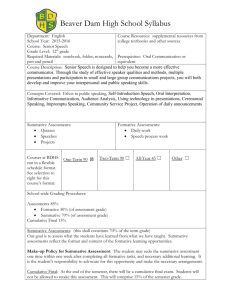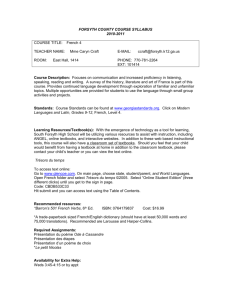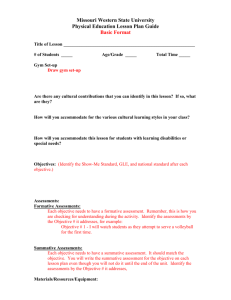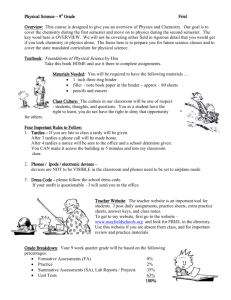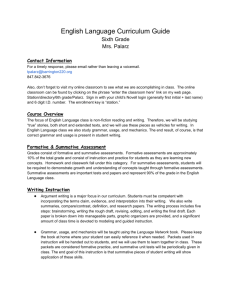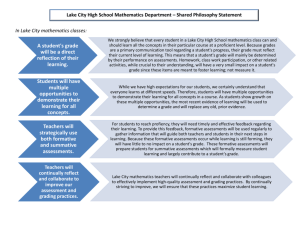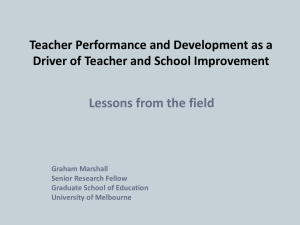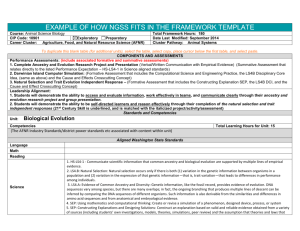Harlan County Public Schools-Informal Teacher Observation Form
advertisement
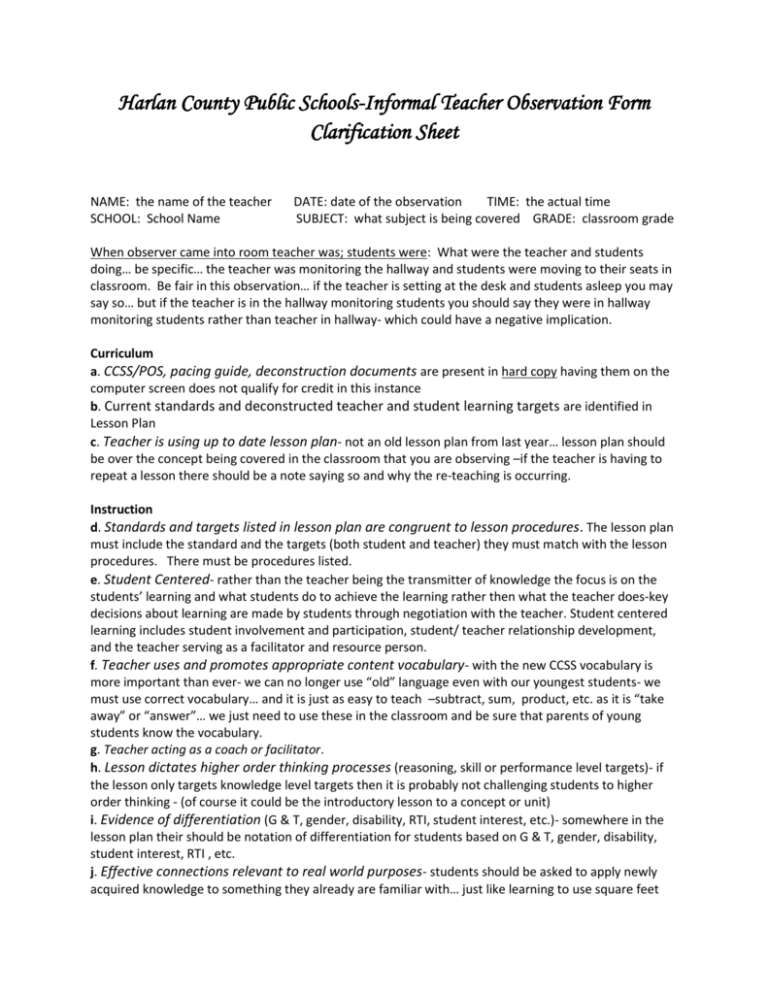
Harlan County Public Schools-Informal Teacher Observation Form Clarification Sheet NAME: the name of the teacher SCHOOL: School Name DATE: date of the observation TIME: the actual time SUBJECT: what subject is being covered GRADE: classroom grade When observer came into room teacher was; students were: What were the teacher and students doing… be specific… the teacher was monitoring the hallway and students were moving to their seats in classroom. Be fair in this observation… if the teacher is setting at the desk and students asleep you may say so… but if the teacher is in the hallway monitoring students you should say they were in hallway monitoring students rather than teacher in hallway- which could have a negative implication. Curriculum a. CCSS/POS, pacing guide, deconstruction documents are present in hard copy having them on the computer screen does not qualify for credit in this instance b. Current standards and deconstructed teacher and student learning targets are identified in Lesson Plan c. Teacher is using up to date lesson plan- not an old lesson plan from last year… lesson plan should be over the concept being covered in the classroom that you are observing –if the teacher is having to repeat a lesson there should be a note saying so and why the re-teaching is occurring. Instruction d. Standards and targets listed in lesson plan are congruent to lesson procedures. The lesson plan must include the standard and the targets (both student and teacher) they must match with the lesson procedures. There must be procedures listed. e. Student Centered- rather than the teacher being the transmitter of knowledge the focus is on the students’ learning and what students do to achieve the learning rather then what the teacher does-key decisions about learning are made by students through negotiation with the teacher. Student centered learning includes student involvement and participation, student/ teacher relationship development, and the teacher serving as a facilitator and resource person. f. Teacher uses and promotes appropriate content vocabulary- with the new CCSS vocabulary is more important than ever- we can no longer use “old” language even with our youngest students- we must use correct vocabulary… and it is just as easy to teach –subtract, sum, product, etc. as it is “take away” or “answer”… we just need to use these in the classroom and be sure that parents of young students know the vocabulary. g. Teacher acting as a coach or facilitator. h. Lesson dictates higher order thinking processes (reasoning, skill or performance level targets)- if the lesson only targets knowledge level targets then it is probably not challenging students to higher order thinking - (of course it could be the introductory lesson to a concept or unit) i. Evidence of differentiation (G & T, gender, disability, RTI, student interest, etc.)- somewhere in the lesson plan their should be notation of differentiation for students based on G & T, gender, disability, student interest, RTI , etc. j. Effective connections relevant to real world purposes- students should be asked to apply newly acquired knowledge to something they already are familiar with… just like learning to use square feet measurements to figure out how much carpet a room needs, time over distance with traveling between time zones, etc. lessons should be tied into previous learning and knowledge- this often will answer “Why do I need to know this?” k. Technology used for instructional delivery. The object here is to use technology as a tool for learning- not as a more modern substitute for an overhead or a movie screen. Have the students do a demonstration using the smart board, or a power point, have the students use the computer to research a topic, explore a concept, etc. l. Research based instructional strategies in use (i.e. Marzano’s Instructional Strategies) The essential 9 strategies are: 1. Identifying similarities and differences 2. Summarizing and note taking 3. Reinforcing effort and providing recognition 4.Homework and practice 5. Nonlinguistic representations 6. Cooperative learning 7. Setting objectives and providing feedback 8. Generating and testing hypotheses and 9. Cues, questions, and advance organizers. These should be evidenced in procedures. m. Lesson is planned appropriately for the specific class period (45 minutes, 72 minutes, etc.) Lessons should state and demonstrate planning for a specific amount of time. It stands to reason that you can’t cover in 45 minutes what you planned for 90 minutes or vice versa. Planning should be specific to the amount of time allotted for each individual class. n. Lesson Plan procedures fully developed- frequently we see lesson plans that include targets, and assessments, page numbers, a text reference, and little else. It is imperative that the procedures are listed: how is the lesson going to be presented? What are students going to discuss? What is the teacher going to propose? What formative assessment questions are going to be asked to determine student knowledge? Etc. Are the procedures listed? No credit is be given if there are no procedures. Assessment o. Assessment aligned to CCSS/POS learning targets- does the assessment check what the learning target/s are stating? Does it reflect the CCSS/POS? If not there is not a match. p. Frequent formative assessment observed or in lesson plan- Simply is their formative assessment viewed during this observation- if not do you see it written in this lesson plan… remember that formative assessment can be as simple as a show of hands, and exit slip, etc. It is an assessment that informs the teacher of where students are in their learning. Teachers should keep a folder with random samples of formative assessments. q. Summative assessment observed or in lesson/unit plan. Summative assessments should be the “summary” of learning. Summative assessment should be near the end of the unit of learning. Teachers should keep a folder of summative assessments. r. Assessment Method match – multiple choice, or constructed response (ORQ or short answer)- that type of assessment should match the learning target and be an appropriate way of assessing the concept being learned. Currently this should be multiple choice, or constructed responses- either short answer or open response. s. Student self assessment and/ or Peer Assessment observed or in lesson/unit plan –currently Kentucky encourages CHETL which includes the use of student self assessment or peer assessment . This will be a look for in lesson and unit plans. Student Engagement t. Student learning target posted- is the student learning target for this lesson plan posted so that students can see it. u. Students using technology as a learning tool or resource. Are students utilizing technology to learn? Are plans in the lesson or unit for students to use technology? v. Students actively participating/engaged (1=85% or below, 2= 86 to 94%, 3=95% or higher)OK..how many have their heads down, not even looking? How many are prepared to answer a question proposed by the teacher? Are they engaged, are they working out the answer, looking through the book to find a reference, etc. What are they really doing? And at what rate? w. Teacher demonstrates strong classroom management skills- Does the teacher have command of the classroom? Are students moving and transitioning well? Does the classroom routine seem set? Are the students running amuck? Is it disorganized? Are students not on task and not paying attention? NOTES: Please use this space to make any comments that you feel need to be noted. You may use this space to make commendations or recommendations. Principal Signature/Teacher Signature If this informal observation is being used by the principal as a walkthrough instrument, the principal and teacher should provide a signature. If this informal observation is being used by the District as a walkthrough instrument teachers are not required to provide a signature.


